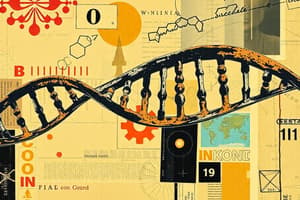Podcast
Questions and Answers
What is the primary reason RNA is needed for cellular functions despite the presence of DNA?
What is the primary reason RNA is needed for cellular functions despite the presence of DNA?
RNA is needed because DNA is too large to leave the nucleus, while RNA is small enough to transport the necessary instructions to the cytoplasm.
How does the composition of RNA differ from that of DNA?
How does the composition of RNA differ from that of DNA?
RNA contains ribose sugar and the nitrogen base uracil, while DNA contains deoxyribose sugar and thymine.
Describe the role of mRNA in protein synthesis.
Describe the role of mRNA in protein synthesis.
mRNA serves as a transcribed copy of DNA that provides the sequence of amino acids needed to form a specific peptide chain.
Explain the functional distinction between ribosomal RNA (rRNA) and transfer RNA (tRNA).
Explain the functional distinction between ribosomal RNA (rRNA) and transfer RNA (tRNA).
What are the implications of RNA being a single-stranded molecule compared to the double-stranded structure of DNA?
What are the implications of RNA being a single-stranded molecule compared to the double-stranded structure of DNA?
What distinguishes the structure of DNA in prokaryotic cells from that in eukaryotic cells?
What distinguishes the structure of DNA in prokaryotic cells from that in eukaryotic cells?
Describe the composition of a nucleotide in DNA.
Describe the composition of a nucleotide in DNA.
Explain the significance of complementary base pairing in DNA structure.
Explain the significance of complementary base pairing in DNA structure.
What role do histones play in the structure of DNA?
What role do histones play in the structure of DNA?
What is chromatin and how does it relate to chromosomes?
What is chromatin and how does it relate to chromosomes?
Identify the types of bonds that stabilize the DNA double helix structure.
Identify the types of bonds that stabilize the DNA double helix structure.
How does the arrangement of the sugar-phosphate backbone contribute to DNA's double helix structure?
How does the arrangement of the sugar-phosphate backbone contribute to DNA's double helix structure?
What is the difference between a chromatid and a chromosome?
What is the difference between a chromatid and a chromosome?
Flashcards are hidden until you start studying
Study Notes
DNA Structure
- Deoxyribonucleic Acid (DNA) is a double-stranded molecule with a double helix structure, primarily found in eukaryotic cell nuclei.
- DNA is composed of nucleotide monomers, which include a sugar (deoxyribose), phosphate group, and one of four nitrogen bases: Adenine, Thymine, Guanine, and Cytosine.
- In eukaryotes, DNA is complexed with histone proteins, forming long strands known as chromatin, which can be further folded into distinct structures called chromosomes.
Chromosomes
- Eukaryotic DNA is organized into chromosomes, each consisting of a long DNA strand wrapped around histones.
- Chromatin exists in a relaxed form but can condense and fold into tightly packed chromosomes.
- A chromatid is one half of a replicated chromosome, appearing as an 'X' shape during metaphase of cell division.
Prokaryotic vs Eukaryotic DNA
- In prokaryotic cells, DNA resides in the cytosol as a circular, unbound molecule.
- Eukaryotic DNA is contained within the nucleus and is associated with proteins, resulting in a linear organization via chromatin.
Nucleotides
- Each nucleotide unit consists of deoxyribose sugar, a phosphate group, and a nitrogen base.
- The four nitrogen bases that constitute DNA are Adenine, Thymine, Guanine, and Cytosine.
Base Pairing
- DNA's double helix is maintained through specific base pairing: Adenine pairs with Thymine and Guanine pairs with Cytosine, connected by weak hydrogen bonds.
- Each DNA strand comprises a backbone formed by alternating sugar and phosphate groups.
RNA Overview
- Ribonucleic Acid (RNA) is a single-stranded molecule synthesized in the nucleus.
- RNA can exit the nucleus into the cytoplasm due to its smaller size compared to DNA.
- Variants of RNA include ribosomal RNA (rRNA), messenger RNA (mRNA), and transfer RNA (tRNA).
RNA Composition
- RNA nucleotides contain ribose sugar and utilize Uracil instead of Thymine, pairing with Adenine during RNA synthesis.
Types of RNA
- Ribosomal RNA (rRNA): Forms the structural and functional components of ribosomes, crucial for amino acid assembly.
- Messenger RNA (mRNA): A transcribed version of DNA that conveys the genetic information required for protein synthesis.
- Transfer RNA (tRNA): Delivers specific amino acids to ribosomes, facilitating the assembly of peptide chains.
Comparison of DNA and RNA
- DNA's structure is double-stranded, while RNA is single-stranded.
- DNA contains the sugar deoxyribose and uses Thymine, whereas RNA features ribose sugar and Uracil in place of Thymine.
Studying That Suits You
Use AI to generate personalized quizzes and flashcards to suit your learning preferences.




